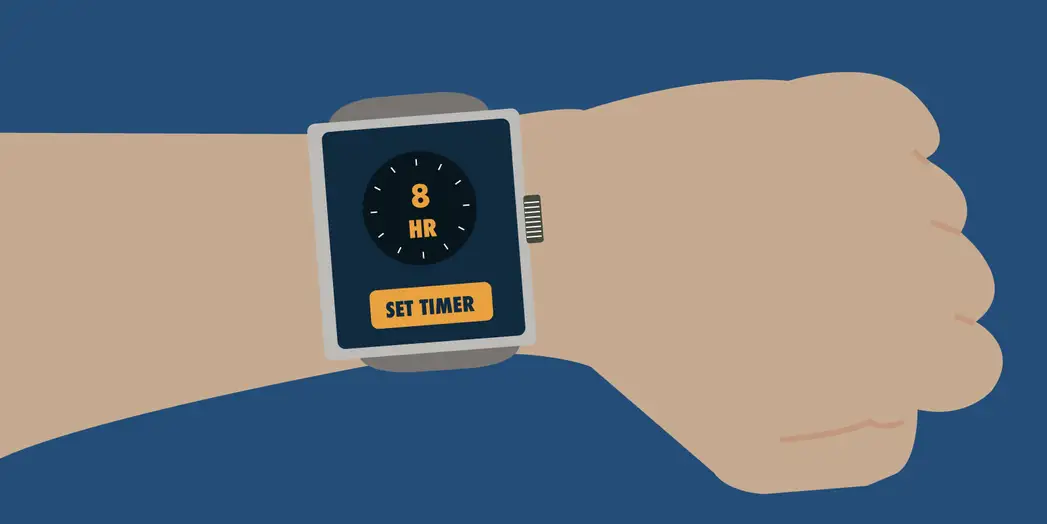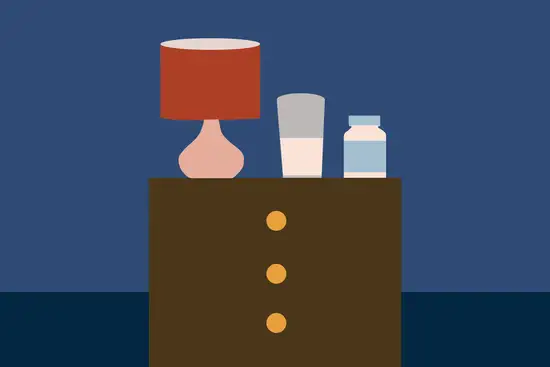Temazepam — Key points
Temazepam is a drug with a long history of use for treating sleep problems. In this article, we’re going to cover the following areas about this sleeping pill:
- what is temazepam?
- dosage information for this drug
- side effects of temazepam
- is temazepam an effective treatment for insomnia?
- drug-free alternatives to temazepam for treating insomnia.
Temazepam has been in use for over 50 years
Temazepam, known by the brand name Restoril in the US, is a drug given to relieve symptoms of insomnia. It’s been used for more than half a century and while its popularity has waned over the years, it’s still prescribed as a short-term treatment for insomnia in the UK, USA and many other countries worldwide.
We’re going to look at how this drug came to be, how it works, and how it’s taken. We’ll discuss the side effects that you may experience and precautions you need to take when on temazepam.
Finally, we’ll look at what the scientific world has to say about the effectiveness of temazepam for treating insomnia and talk about why guidelines across the globe consider drug-free approaches to be the first-line treatment for insomnia.
Let’s get started with a little background on how temazepam was actually developed and what exactly it is about this drug that makes it suitable for people with insomnia.
Sleep better without temazepam
People who have sleeping problems often turn to temazepam , hoping for a quick fix. Most people don’t realise that there are more effective ways to treat your sleeping issues without side effects. With Sleepstation you can significantly improve your sleep without relying on medication. Sleepstation will help you:
- fall asleep quickly
- get all the sleep you need
- spend less time awake in bed
- wake feeling refreshed.
Sleep better without temazepam
Get support from sleep experts, plus self-help tools.
Working with an expert who really grasps your situation is key to unlocking real sleep, effortless sleep. You deserve to sleep well and to work with people who have the right knowledge and expertise to help you get there.
Begin your journey to a lifetime of better sleep with:
- a full week of unlimited access to our highly-trained sleep coaches.
- direct contact and professional advice, with no waiting lists.
- expert insights to control and repair your sleep.
- lifetime access to an ever-growing library of sleep tools and resources.
A short history of temazepam
Temazepam was first made in the early 1960s, but it was only in the late ‘60s that it was investigated as a treatment option for insomnia.1
During the ‘70s temazepam was studied extensively in clinical trials to see if it would be an effective sleeping pill for people with insomnia. In 1981, temazepam was licensed in the USA under the brand name Restoril for treatment of insomnia.
The drug gained huge popularity in the ‘80s and ‘90s across the world as an insomnia treatment. Temazepam belongs to the benzodiazepine family of drugs which became popular as ‘safer’ alternatives to the older sleeping pills, the barbiturates. They were considered to be less toxic than barbiturates, with lower risk for abuse, addiction and overdose.2
Temazepam itself was considered to be one of the safer benzodiazepines because its effects wear off relatively quickly compared to other benzodiazepines. This means it’s less likely to leave users with residual effects the morning after taking it.3
So, it seemed like temazepam was proving to be a good alternative to other sleeping pills. It became one of the most prescribed sleeping pills across the western world. But there was a drawback.
At the same time as it was gaining popularity as an insomnia treatment, it was also becoming popular as a recreational drug.
The misuse of temazepam led to changes to UK laws from the 1990s onwards. Temazepam became more tightly controlled and was reclassified from being a schedule 4 drug to a schedule 3 drug.
The Misuse of Drugs Regulations in the UK categorises drugs into one of five ‘schedules’, with schedule 1 having the tightest controls and schedule 5 being under the lowest level of control. The gel-filled capsule version of temazepam, which was commonly abused, was subsequently discontinued in 1996.
Similar controls came in across countries where temazepam abuse had become rife and today, worldwide, its use is tightly regulated. To understand more about the popularity of temazepam as both an insomnia treatment and its misuse as a recreational drug, we need to look at what it does in the body.
How does temazepam work?
As we’ve mentioned, temazepam is a benzodiazepine, and compounds in this family share a common mechanism of action. Benzodiazepines produce feelings of calm and sedation, and they do this by enhancing the effect of a chemical called gamma aminobutyric acid (GABA).4
Imagine the nervous system as a network of roads running through your body. Electrical signals are sent along these roads to and from the brain — you can think of these as cars racing along the roads.
Neurotransmitters are chemical messengers involved in this signalling. Some neurotransmitters make the cars race along faster or increase how many cars are on the road. Others slow down the progress of the traffic, kind of like a roadblock or speedbump.
GABA is one of the slowing down types. In technical terms, it’s an inhibitory neurotransmitter. This means that it can act like a roadblock or speedbump and slow down or block the transmission of signals. By slowing things down, it decreases activity in your nervous system.
Hopefully, so far, so good. To recap, the nervous system is like an information highway running throughout the body to the brain and GABA acts like a roadblock or speed bump to block or slow down the flow of traffic.

So, how does this relate to temazepam? Benzodiazepines such as temazepam work by enhancing GABA signaling. So, it essentially helps to keep the roadblocks up for longer. This slows down the signals getting along the highway even more than GABA already does.4
In reality, it’s slowing down activity in your nervous system, so signals being transmitted between nerve cells to the brain become slower and less active. It slows down brain activity and so helps you to feel calm and relaxed.
This is why temazepam is sometimes referred to as an anti-anxiety medication (or anxiolytic). GABA is heavily involved in regulating anxiety and by enhancing GABA, temazepam lowers feelings of anxiety. By making a person feel calm and relaxed, it can also allow their body to fall asleep.4
This is where temazepam’s potential for misuse as a recreational drug comes into play. Unfortunately, temazepam is addictive, both physically and mentally.
The feelings of calm and relaxation that temazepam induces can also be accompanied by a sense of euphoria (extreme happiness). This can make people want to take more of the drug, either to recreate the effect or to increase this feeling.
It’s often misused in combination with other drugs, which can greatly increase the risk of overdose. People frequently combine temazepam with other GABA-modulating drugs, such as alcohol, which can lead to dangerous levels of sedation and a heavy reduction in breathing rate.
What is temazepam used for?
In the UK temazepam is licensed for use as a short-term treatment for insomnia. It’s also used as a premedication (premed) before medical procedures, to reduce anxiety and help you relax.5 It’s unlicensed for use as a sedative before dental procedures.
This means that it has been found to be useful for sedating people before dental work, but clinical trials haven’t been carried out to verify how effective and safe it is when used for this purpose.
In the USA, temazepam is FDA approved for the short-term treatment of insomnia. They define short-term as being generally 7-10 days.6 The NHS indicates that it should be taken for no more than four weeks.5
Is temazepam a controlled substance?

As we mentioned earlier, temazepam is a controlled drug in the UK, which means that it’s only available on prescription and subject to high levels of regulation. Controlled drugs are usually those which can be especially addictive or harmful.
In the USA, temazepam is a schedule 4 controlled substance, which means it’s classed as a drug that may be abused and can lead to physical dependence or addiction. Controlled substances in the USA are classified on a scale of 1-5 according to their risk for abuse.
Schedule 1 substances have the most potential for abuse and schedule 5 the least. Classed as a schedule 4 substance, temazepam is considered to have a fairly lower potential for abuse and low risk of dependence or addiction.
Taking temazepam for longer than necessary can lead to your body becoming used to the drug and so it becomes ineffective. This may lead some people to take a higher dose to get the desired effect.
The problem with this approach is that taking greater than the prescribed dose of temazepam can be really dangerous. It can make you excessively drowsy and can cause breathing problems, coma and even death.7
You shouldn’t take temazepam with alcohol either as the combination of the two together can increase side effects such as drowsiness, dizziness, slowed breathing and overdose.
Taking temazepam for longer than recommended or at higher doses can also increase the risk of addiction, so it’s vital to keep to your prescribed dose. When temazepam is taken at the prescribed dose and for the recommended period of time, it’s considered to be safe.
Dosage of temazepam
Temazepam is commonly available in the UK in tablet form at 10 and 20mg strengths and in liquid form at 10mg/5ml strengths.8 It’s also available under the brand name Restoril in capsule form at strengths of 7.5, 15, 22.5 and 30mg.6
When it’s taken for insomnia, NHS guidelines give the starting dose of 10-20mg per day, taken once a day, though doses of 30-40mg can be taken in exceptional circumstances.5 8 In the USA the range is 7.5-30 mg, once a day at bedtime.7
Older adults, especially those at risk of falls, may be given a lower dose to help them sleep. Older people may be more sensitive to the effect of temazepam due to changes that occur in how long it takes the body to metabolise certain drugs as we age.
Because temazepam makes you sleepy, you should aim to have eight hours between taking it and when you need to be awake. This is to give your body enough time to metabolise the drug, so you’re not groggy or sleepy when you start your day.

Temazepam is considered to have a relatively short half-life compared to some of the other benzodiazepine drugs.3
For temazepam, the half-life is somewhere between 5-20 hours3 so, within this time range, your body should have removed 50% of the drug from your body. This can be longer for some people, especially older adults.
Because it’s considered to have a fairly short half-life, if you take it at bedtime, its effects should have worn off when you wake up.
If you find you’re waking up the morning after taking temazepam feeling sleepy, dizzy or just not yourself, then it’s worth speaking to your healthcare provider. You shouldn’t drive, bike or operate heavy machinery if temazepam is making you feel like this.
Temazepam should only be taken for a short period of time, which may be anything from 1-4 weeks.5 8 When it’s taken at a low dose for a short duration, it’s not likely to be addictive.
Temazepam shouldn’t be taken during pregnancy as there’s a risk of it causing problems with foetal development. It should be avoided whilst breastfeeding as small amounts of temazepam pass into breast milk and there’s a risk that it could make the baby sleepy.
Side effects
Common side effects of temazepam can include:
- sleep disturbance
- reduced alertness
- dry mouth
- feeling lightheaded, unsteady or dizzy
- altered mood, depression or anxiety
- a ‘hangover’ feeling the day after taking the drug.5 6 7
Serious side effects are rare but can include:
- jaundice: the whites of your eyes and your skin turning yellow
- difficulty passing urine
- palpitations
- delusions and hallucinations
- weakness or poor coordination
- slurred speech
- memory loss or confusion
- thoughts of self-harm or suicide.5 7
These side effects require immediate treatment and should not be ignored. If you experience any of these side effects, you should call your doctor or seek emergency medical care straight away.
Temazepam withdrawal, dependence and tolerance
Like with all of the benzodiazepines, there’s a risk of physical and mental dependence developing with temazepam.
If you’re taking temazepam as directed by your doctor but you start to notice that it’s not having the same effects as when you started taking it, your body may be becoming used to the drug. This is called tolerance.
In some instances, someone who has developed tolerance to a drug might self-medicate and increase the dose to try and get the required effect. This is a sign of drug dependence.
If you feel like you can’t function without temazepam then you’re likely becoming dependent on the drug and should speak to your healthcare provider.
When temazepam is taken for long durations or at higher doses, it can be difficult to stop taking it. In these scenarios, you shouldn’t stop taking temazepam ‘cold turkey’ as it can lead to symptoms of withdrawal.
You may experience symptoms such as:
- depression, anxiety or confusion
- headache, dizziness or problems concentrating
- nausea, stomach cramps or diarrhoea
- hallucinations, feeling disconnected from reality
- rebound insomnia.
If you’ve taken temazepam for a longer duration or at a higher dose, your healthcare provider will be able to help you to taper off the drug slowly, so the risk of withdrawal effects is minimised.
Is temazepam a good treatment option for insomnia?
Scientific studies have examined temazepam and its suitability as a sleep aid for people with insomnia for more than 50 years, so we have a lot of information about how it may help people to sleep.
It’s been shown that temazepam taken at night can help people get to sleep quicker when they go to bed, awaken less and can improve sleep quality and how long a person sleeps for.3 9 10
So, if temazepam’s so good at improving all of these areas of sleep, what’s the drawback?
Firstly, as we’ve mentioned earlier, you can only take temazepam for a short period of time. Your body quickly gets used to the effects of the drug and it stops working.
Secondly, taking it can be habit-forming and there’s a temptation to take higher doses to get the desired calming effect on sleep. So, the risk of abuse and addiction can’t be ignored.
And thirdly, while drugs like temazepam can bring you relief from symptoms of insomnia, they can’t address the root causes. Drugs that are given for short-term treatment of insomnia can only mask your symptoms and provide you with some temporary relief.
Clearly, temazepam is not a long-term option to deal with a sleep problem. So, what is?
According to international clinical guidelines, the first-line treatment for insomnia is a completely drug-free approach that’s been around for decades and is backed by years of scientific research. Let’s talk more about this now.
Drug-free treatments for insomnia

What is this mystery treatment that involves no pills? The gold standard treatment for insomnia is a form of talking therapy called Cognitive Behavioural Therapy for insomnia (CBTi).
You may have heard of CBT before. It’s a form of therapy that can help you to work through problems by changing the way you think and behave. It helps you to get rid of negative thought processes and adopt healthy, more positive ways of thinking and behaving.
It’s used to treat a host of problems and disorders, including:
- anxiety and depression
- alcohol and substance abuse
- obsessive compulsive disorder (OCD)
- eating disorders
- post-traumatic stress disorder (PTSD)
- a range of mental health disorders.
CBT techniques have been around for many decades and have been gradually refined and improved over the years. In the present day, CBT is a popular and effective method of treating many disorders, with a wealth of scientific data to back up its success.
CBT for insomnia (CBTi) is one form where research has shown this technique to be extremely effective. This is the method we use in our online sleep clinic and we’ve helped thousands of people to take back control of their sleep through our course.
We use CBTi techniques to change your perception of sleep, improve your knowledge and understanding of what goes into healthy sleep and to help you overcome whatever is coming between you and the sleep you deserve.
Our programme is extremely effective and comes highly recommended by the people we’ve helped. You can complete the course from the comfort of your own home, knowing that you’ll be fully supported by a team of sleep experts, therapists and dedicated sleep coaches who have the knowledge and expertise to guide you back to refreshing sleep, night after night.
So if you’re looking to get back to sleeping well, without sleeping pills, why wait? Answer a couple of short questions about your sleep now and see how Sleepstation can help you get back on the road to good sleep.
Summary
- Temazepam has been around for a long time and continues to be prescribed as a short-term treatment option for insomnia.
- Your body naturally becomes used to the effects of temazepam with time, so it loses its effect.
- It comes with a risk of addiction and should only be taken as prescribed.
- Temazepam can’t get to the root of why you’re not sleeping well.
- Sleepstation uses completely drug-free approaches to improve your sleep, long-term.
References
- Maggini C, Murri M, Sacchetti G. Evaluation of the effectiveness of temazepam on the insomnia of patients with neurosis and endogenous depression. Arzneimittelforschung. 1969;19(10):1647–52. ↩︎
- Wick JY. The history of benzodiazepines. Consult Pharm. 2013;28(9):538–48. ↩︎
- Heel RC, Brogden RN, Speight TM, Avery GS. Temazepam: A review of its pharmacological properties and therapeutic efficacy as an hypnotic. Drugs. 1981;21(5):321–40. ↩︎
- Jewett BE, Sharma S. Physiology, GABA. StatPearls Publishing; 2021. ↩︎
- Temazepam: a medicine to treat sleeping problems (insomnia) [Internet]. Nhs.uk. 2022 [cited 16 May 2022]. Available here. ↩︎
- Restoril™ (temazepam) Capsules USP [Internet]. Accessdata.fda.gov. 2022 [cited 16 May 2022]. Available here. ↩︎
- Restoril Drugs.com. [cited 2022 May 16]. Available here. ↩︎
- Excellence N. TEMAZEPAM | Drug | BNF content published by NICE [Internet]. Bnf.nice.org.uk. 2022 [cited 16 May 2022]. Available here. ↩︎
- Monti JM, Torterolo P, Pandi-Perumal SR. The effects of benzodiazepine and nonbenzodiazepine agents, ramelteon, low-dose doxepin, suvorexant, and selective serotonin 5-HT2A receptor antagonists and inverse agonists on sleep and wakefulness. Clin Med Insights Ther. 2016;8:CMT.S38232. ↩︎
- Sateia MJ, Buysse DJ, Krystal AD, Neubauer DN, Heald JL. Clinical practice guideline for the pharmacologic treatment of chronic insomnia in adults: An American Academy of Sleep Medicine clinical practice guideline. J Clin Sleep Med. 2017;13(2):307–49. ↩︎


